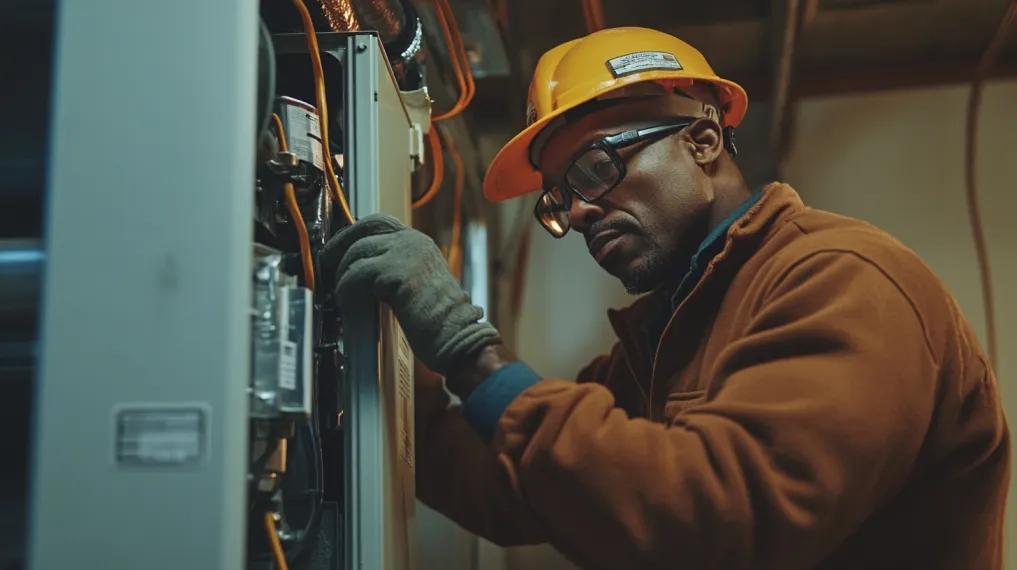How Does a Heat Exchanger Work?

The heat exchanger is a key furnace component, responsible for delivering warm air safely and efficiently to your home. Understanding how it works can help you appreciate its importance in your heating system and why maintaining it is essential. HVAC.com explores what a heat exchanger is, how it operates, and why its condition impacts your safety and comfort.
What Does a Heat Exchanger Do?
A heat exchanger is a metal chamber or series of metal tubes inside your furnace designed to transfer heat from burning gas or oil to the air that circulates through your home. It’s constructed from durable materials – typically steel or other alloys – that can withstand high temperatures and corrosive combustion byproducts.
While the heat exchanger is responsible for heating air, its other critical function is to keep combustion gasses, such as carbon monoxide, contained within its sealed system, so they do not mix with the air that heats your home.
What Does a Heat Exchanger Look Like?
A heat exchanger typically looks like a series of curved or tubular metal chambers made of steel, aluminum, or other heat-resistant alloys, often resembling a set of coiled pipes or a long, ribbed metal box inside your furnace.
Its design allows maximum surface area exposure to heat, enabling efficient transfer of heat from combustion gasses to the surrounding air. The tubes or chambers are usually positioned above the furnace burners, and you might see them lined up in rows or wrapped in a series of coils, depending on the furnace model.
How Does a Heat Exchanger Work?
- Ignition and Combustion: When your thermostat signals the need for heat, the furnace’s burners ignite, producing a flame that heats the metal walls of the heat exchanger. This process creates a sealed combustion chamber where the fuel is burned.
- Heat Transfer: The heat generated by the combustion process warms the metal surface of the heat exchanger.
- Air Circulation: As the heat exchanger warms up, the furnace’s blower fan turns on and pushes cool air from your home over the outside of the heat exchanger. The air absorbs the heat from the exchanger’s hot metal surface, raising its temperature.
- Distribution of Warm Air: The heated air is circulated through your ductwork and out into your home, providing you with comfortable and consistent warmth.
- Exhaust: The combustion gasses inside the heat exchanger are directed out of your home through a flue or vent, ensuring that any dangerous byproducts do not contaminate your indoor air.
Common Heat Exchanger Problems
Since the heat exchanger deals with intense heat and corrosive gasses, it’s susceptible to wear and damage over time. Here are some common issues that can occur:
Cracks and Corrosion
Repeated heating and cooling cycles can cause the metal of the heat exchanger to expand and contract, leading to cracks. Corrosion can also occur, especially in older units, due to the constant exposure to moisture and combustion gasses.
Carbon Monoxide Leaks
A cracked heat exchanger can allow carbon monoxide and other dangerous gasses to leak into your home’s air supply, posing a serious health risk. This is why regular furnace maintenance and inspections are crucial.
Reduced Efficiency
If the heat exchanger is dirty or damaged, it can’t transfer heat as effectively, causing your furnace to work harder and use more energy. This not only increases your energy bills but also puts additional strain on the system, potentially leading to more frequent repairs.
Because of the risk of carbon monoxide leaks, problems with the heat exchanger can be quite serious. Any issues with your furnace’s heat exchanger should be addressed immediately by a professional HVAC technician.
How to Maintain Your Heat Exchanger
Routine maintenance is key to keeping your heat exchanger – and your entire furnace – in good working order. Homeowners should take the following steps to care for this important furnace component:
- Annual Furnace Inspections: Have your furnace inspected annually by a qualified HVAC technician. They can check the condition of the heat exchanger and other critical components, ensuring there are no cracks or signs of wear.
- Regular Cleaning: Dust and debris can accumulate inside your furnace, impacting its efficiency. Professional cleaning during an annual furnace tune-up removes buildup from the heat exchanger, which improves the process of heat exchange.
- Replace Air Filters: Dirty air filters restrict airflow, causing the furnace to overheat, which can stress the heat exchanger. Regularly replacing your filters helps maintain proper airflow and reduces the risk of damage.
- Monitor Your Furnace’s Performance: Pay attention to signs that your furnace might be struggling, such as unusual noises, frequent cycling, or uneven heating. These could indicate a problem with the heat exchanger or another part of the system.